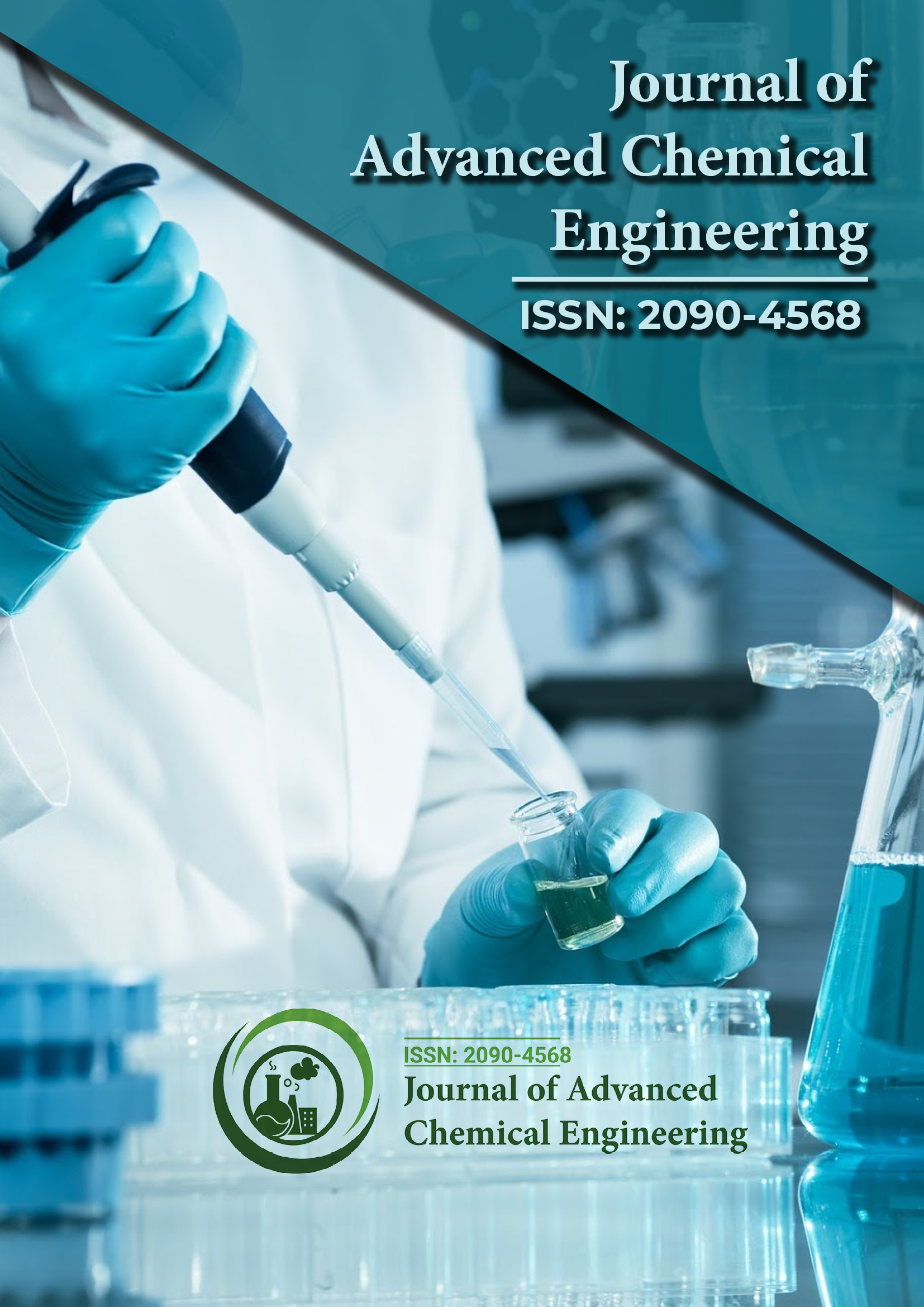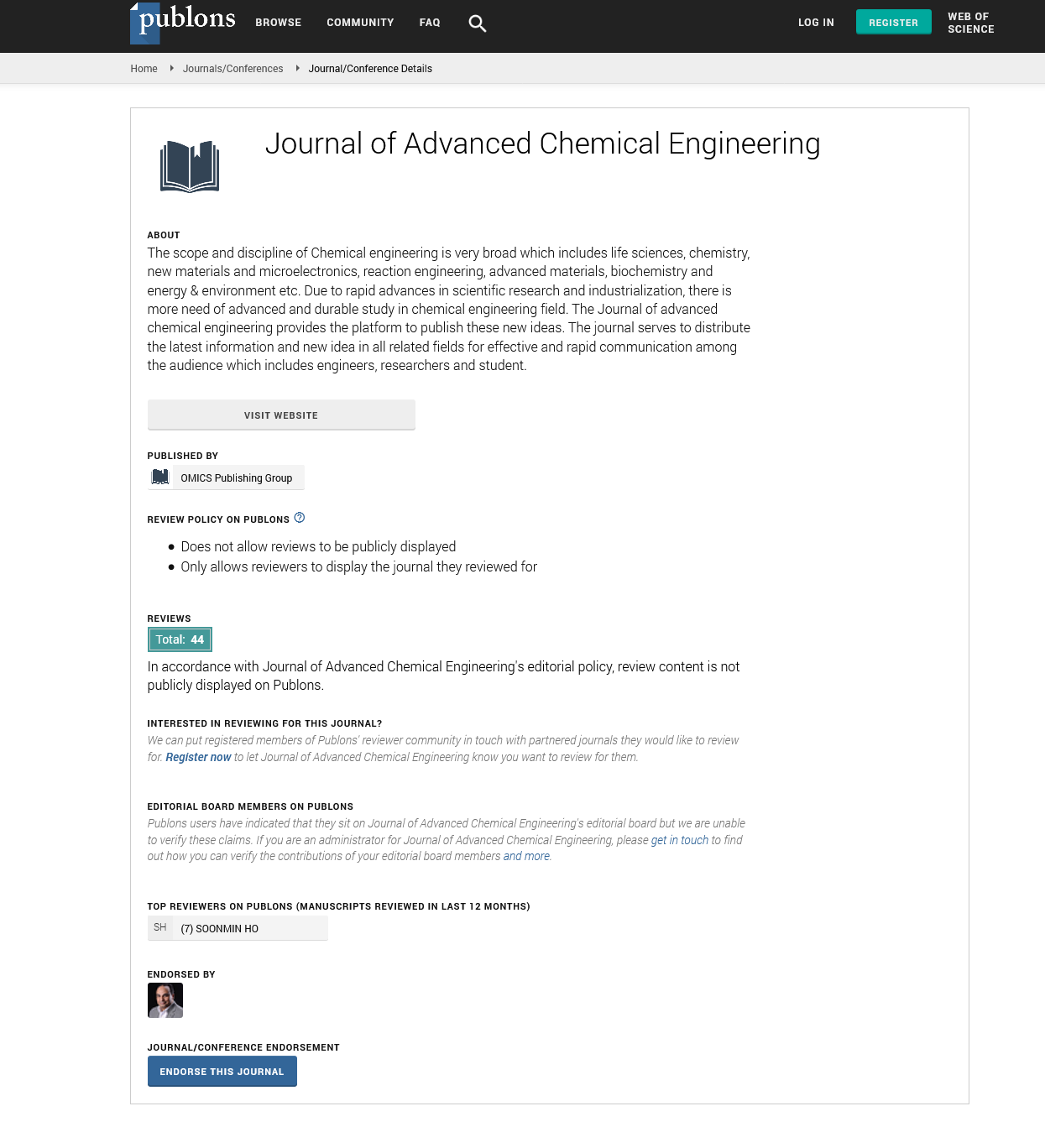Indexed In
- Open J Gate
- Genamics JournalSeek
- Smithers Rapra
- RefSeek
- Directory of Research Journal Indexing (DRJI)
- Hamdard University
- EBSCO A-Z
- OCLC- WorldCat
- Scholarsteer
- Publons
- Geneva Foundation for Medical Education and Research
- Google Scholar
Useful Links
Share This Page
Journal Flyer

Open Access Journals
- Agri and Aquaculture
- Biochemistry
- Bioinformatics & Systems Biology
- Business & Management
- Chemistry
- Clinical Sciences
- Engineering
- Food & Nutrition
- General Science
- Genetics & Molecular Biology
- Immunology & Microbiology
- Medical Sciences
- Neuroscience & Psychology
- Nursing & Health Care
- Pharmaceutical Sciences
Opinion Article - (2025) Volume 15, Issue 1
Microfluidic Reactors for High-Throughput Chemical Synthesis: A New Era in Continuous Manufacturing
Thomas McGregor*Received: 03-Mar-2025, Manuscript No. ACE-25-29157; Editor assigned: 05-Mar-2025, Pre QC No. ACE-25-29157 (PQ); Reviewed: 19-Mar-2025, QC No. ACE-25-29157; Revised: 26-Mar-2025, Manuscript No. ACE-25-29157 (R); Published: 02-Apr-2025, DOI: 10.35248/2090-4568.25.15.362
Description
The traditional model of chemical synthesis has long relied on batch reactors, which, despite their widespread use, pose challenges in scalability, process control, safety, and energy efficiency. In contrast, continuous flow systems have steadily gained attention for offering improved process intensification, reproducibility, and automation potential. Among these, microfluidic reactors miniaturized systems that manipulate fluids at the sub-millimeter scale are at the forefront of modern chemical manufacturing, particularly for high-throughput synthesis in the pharmaceutical, fine chemical, and materials sectors.
Microfluidic reactors operate within channels typically ranging from tens to hundreds of micrometers in width. The small dimensions ensure laminar flow conditions, enabling precise control over residence time, temperature, and mixing efficiency. This fine control allows for more predictable reaction kinetics, higher yields, and safer handling of exothermic or hazardous reactions. Furthermore, microreactors significantly reduce reagent consumption and waste generation, aligning with the goals of sustainable chemistry.
One of the most compelling advantages of microfluidics is its ability to conduct multiple reactions in parallel through device arrays. High-Throughput Experimentation (HTE) using microreactors allows rapid screening of catalysts, solvents, reaction conditions, and reactant concentrations. This accelerates the discovery and optimization of synthetic pathways, reducing both time and cost in research and development. The pharmaceutical industry, in particular, has adopted microfluidic platforms to screen drug candidates and optimize Active Pharmaceutical Ingredient (API) synthesis with minimal material usage.
Microreactors have also shown significant potential in handling reactions that are difficult to scale in traditional batch processes. For example, diazotization reactions, which involve unstable intermediates, are inherently safer in microchannels due to low reaction volumes and efficient heat removal. Similarly, photochemical and electrochemical reactions, which require uniform energy distribution, benefit from the high surface-areato- volume ratio offered by microfluidic systems.
Integration of microreactors with online analytical tools such as mass spectrometry, infrared spectroscopy, and chromatography enables real-time monitoring and control of chemical transformations. This allows for the implementation of feedback loops that maintain optimal conditions and quickly adapt to variability in feedstocks or environmental parameters. Such capabilities are essential for Quality-by-Design (QbD) approaches in pharmaceutical manufacturing, where product quality must be maintained consistently across production cycles.
The fabrication of microreactors has also evolved significantly, with techniques ranging from soft lithography using Polydimethylsiloxane (PDMS) to micromachining of metals, glass, and ceramics. More recently, 3D printing technologies have enabled rapid prototyping of complex microfluidic geometries, including multi-inlet designs, helical channels, and integrated mixing zones. Material compatibility remains an important consideration, especially when handling aggressive solvents, strong acids or bases, or high-temperature conditions.
Scalability, often viewed as a limitation of microreactors, is being addressed through numbering-up strategies, where multiple microreactors operate in parallel to meet desired throughput. This modular approach offers greater flexibility and lower risk than traditional scale-up, which often encounters issues related to mixing and heat transfer. Commercial systems now exist with hundreds of parallel microchannels, enabling the production of kilograms of product per day with consistent quality.
In addition to synthetic chemistry, microfluidics is finding applications in crystallization, nanoparticle synthesis, and biocatalysis. Continuous crystallization in microreactors offers better control over particle size distribution and polymorph formation, which is critical for drug solubility and bioavailability. Similarly, microfluidic-assisted nanoparticle production enables the generation of monodisperse particles with tunable size and surface properties, useful in targeted drug delivery and sensor applications.
Environmental and economic benefits of microfluidic reactors are also notable. The reduced footprint, lower utility demands, and enhanced atom economy contribute to a smaller environmental impact. Moreover, the digitization and automation of microfluidic platforms reduce labor costs and allow remote operation, which is particularly advantageous in highly regulated or hazardous production environments.
Efforts are ongoing to develop anti-fouling coatings, self-cleaning channel designs, and integrated cleaning cycles to overcome these issues. Furthermore, regulatory frameworks must evolve to accommodate microfluidic technologies in pharmaceutical production, requiring robust validation protocols and safety assessments.
Citation: McGregor L (2025). Microfluidic Reactors for High-Throughput Chemical Synthesis: A New Era in Continuous Manufacturing. Adv Chem Eng. 15:362.
Copyright: © 2025 McGregor L. This is an open-access article distributed under the terms of the Creative Commons Attribution License, which permits unrestricted use, distribution, and reproduction in any medium, provided the original author and source are credited.

